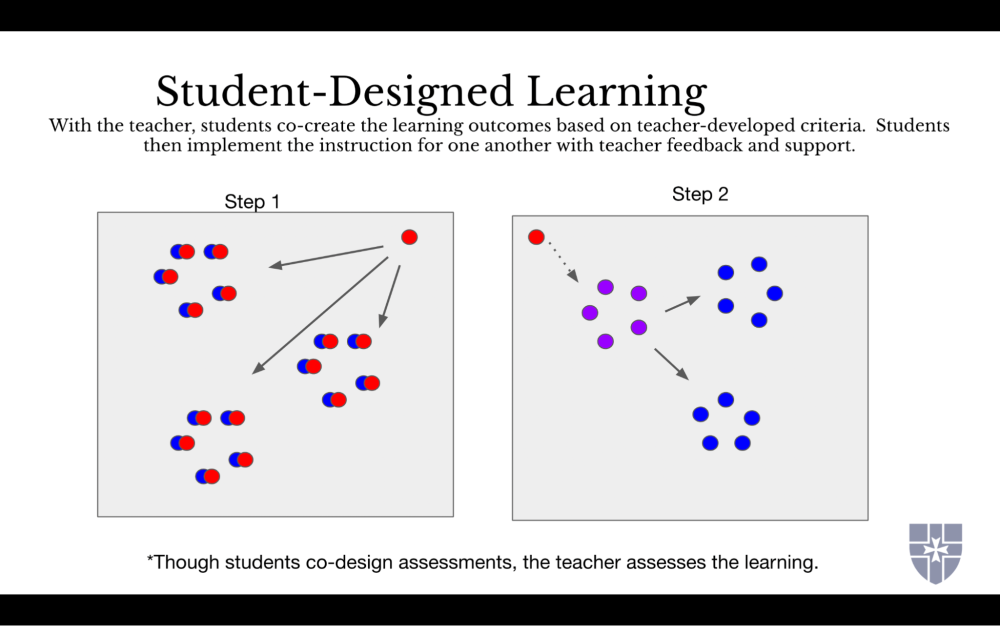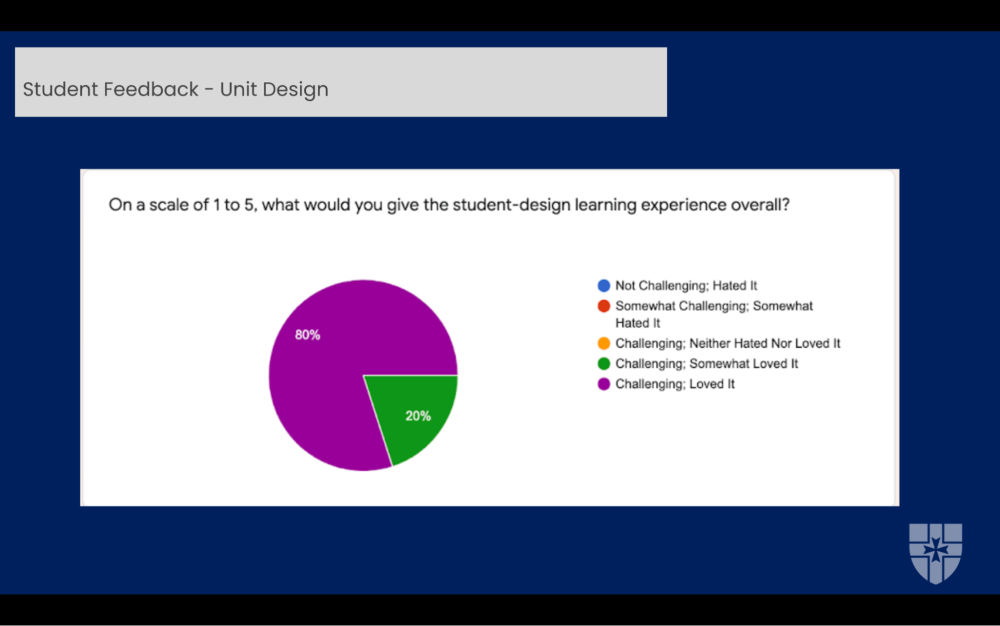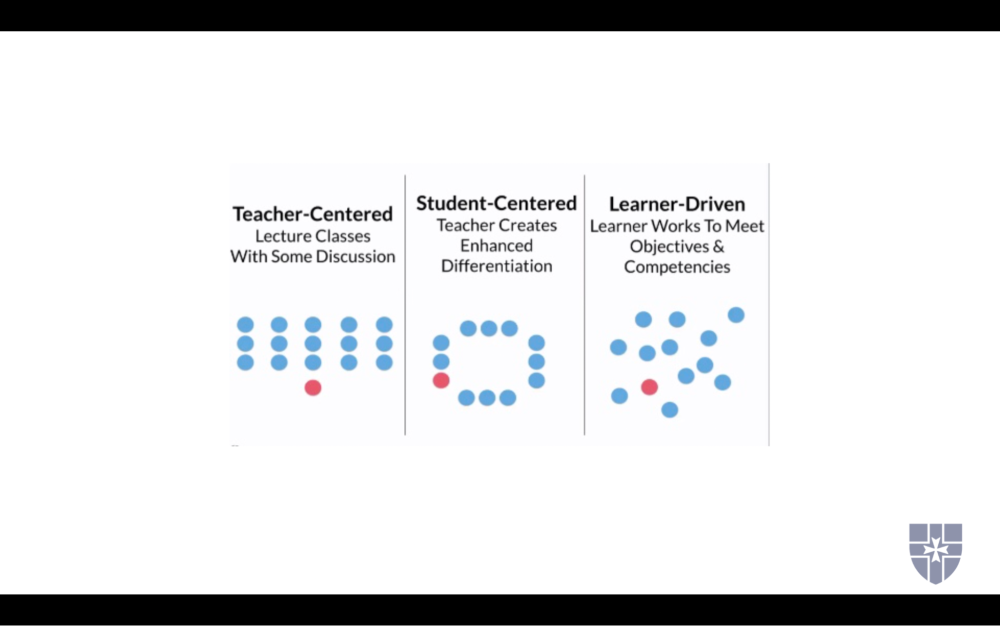An Introduction to Student Co-Designed Learning
Three years ago, Jack, a freshman at the time, asked me if I would consider offering an English seminar on the 1980s when he was a senior.
“You bet,” I responded. “On one condition. You co-design the seminar with me.”
Jack retorted with a furrowed brow, “Are you serious?”
“Absolutely.”
For the next hour, we talked shop and dropped nascent ideas into a Google doc of possible themes, texts, articles, assessments, etc.
Three years later we rolled out the seminar, “Growing Up in the 80s.”
On the first day of class, Jack and I explained how we wanted the other students to put their fingerprints on the curriculum’s footprint. We divided up the seniors into three teams, handed out the instructions and the student-facing rubric, and then set them loose to design a 10-lesson unit.

Step one in the student co-design process involved me (red dot) giving guidance and feedback to my “students-teachers-in-training” (blue dots) as they designed deliverables, rubrics, texts, lesson plans, and assessments.
During the design process, it was breathtaking to watch my students experience what psychologist Mihaly Csikszentmihalyi calls “ flow” - that point in time where we are unconsciously conscious.
55 minute class periods could have been 80 or 90 minute classes!
The final team products included a unit on High School in the 80s, Raised on TV, and White versus Black America in the 80s.
Step two involved me (red dot) assisting the “student-teacher teams” (purple dots) as they led their classmates (blue dots) through their unit. I facilitated regular “team huddles” throughout the unit to give feedback and reflect with them on what was working and where they might want to adapt and pivot going forward.
At the seminar’s conclusion, I surveyed my students about the co-design experience:
- “Getting to design and implement a unit for my peers was not only very fun, but allowed me to think more critically and creatively about the texts/movies we wanted to incorporate and Growing Up in the 80s as a whole.”
- “This experience has truly unveiled the difficulties of being a teacher as unit design was way more intricate than I expected. With that being said though, it was also incredibly fun and fulfilling to watch our peers enjoy everything we planned out for them.”
- “I really enjoyed designing a Unit because we got to choose a topic and primary sources that we found really interesting and that we hoped our peers would enjoy as well. We were thrilled to discover that our peers were interested in what we were curious about.”
- “I thought it was awesome how quite a good portion of the class really connected with the works my team chose.”

In 2019, I participated in GOA’s Summer Design Institute and attended a workshop on student co-design learning. The whole experience reminded me of the scene in Back to the Future where Marty McFly jams out on the electric guitar to the song “Johnny Be Good”. Everyone at the prom, including Marty’s parents, look at him with shock, awe, and concern. That’s what the GOA workshop was for me - pedagogical rock n’ roll! A futuristic vision of education. Notably, that shake, rattle, and roll moment launched me on a journey into student co-designed learning.
Not long ago I facilitated a workshop on student co-design learning with colleagues.
It was my attempt at a “Johnny Be Good” riff.
Based on Simon Sineck’s TedTalk advice, I led off the workshop with my Why.
Not long ago I read the book Get Your Ship Together. It is the story of how U.S. Navy Commander Mike Abrashoff turned around a struggling ship, USS Benfold. The arresting transformation came down to one animating principle: “If we create it, we own it.” Once the sailors were empowered to create the ship’s culture, buy-in followed, and performance soon skyrocketed.
All of us want our students to feel a sense of agency; to have voice and choice in their learning.
All of us want our students to experience flow through engagement; a mix of challenge and fun.
All of us want our students to achieve mastery; that “holy grail” of fluency and transfer with skills and knowledge.
The key I’d found in my classroom - to foster agency, engagement, and mastery - was what Commander Abrashoff discovered aboard his ship - students respond best when they feel empowered to help create the kind of learning experience they want to have. It’s no longer curriculum being done to students. But with them. And by them. And through them.
Notably, psychologist Daniel Pink’s seminal research on motivation would support this paradigm shift in our instructional design. The same can be said of Dr. Daniel Willingham and his pioneering research in the field of cognitive psychology. The former helps us understand the power of intrinsic motivation in student co-designed learning. The latter helps us understand the importance of meaning-making in student co-designed learning.
That said, for me, shifting to student co-design learning has been a slow process. Partly because of the pandemic. And partly because of my school’s very traditional ethos.

Metaphorically, I like to equate student co-design learning to a Russian doll. Student co-design learning represents one small figurine nested within larger figurines that represent other pedagogical designs - teacher-centered, student-centered, and learner-driven. All are interconnected and useful for instruction. Student co-design learning just gives me one more doll to play with in my classroom.
As I’ve moved “further up and further in” into student co-design learning, I’ve gleaned some practical wisdom along the way.
Start small. Look for one assessment or lesson where you can invite students to co-design with you. For me, it was discussion skills. I simply adopted GOA’s design process to do this with my students.
Keep it simple. There is a simplicity beyond complexity, as T.S. Eliot says. Aim for a simple “deliverable” with a couple simple steps. I did this recently in my 9th grade Global History class. My students were charged with the task to co-create a practice test over the Renaissance. The results on the real test were the best I’ve ever had.
Aim for the "familiar zone." With my seniors (in 2019), I started with discussion skills because I knew my students were most familiar with these skills because they engage often in Harkness discussions. Over time, I scaffolded my student up into the “confusion zone” where there was more ambiguity and complexity around the design process.
“Clear is Kind.” Brene Brown says it best. Guardrails are important. For example, I’ll be clear that all assessment co-designs will be graded by me. All texts must be vetted by me. And a clear, student-facing rubric does wonders to set the expectations.
Resource Well. In student feedback, I discovered students valued particular resources, like Jennifer Gonzalez’s blog posts on lesson design and one-point rubrics; in addition, I provided them with some of my own assessments, rubrics, and surveys; finally, I gave them access to prior student products (see Sample A; Sample B).
Feed Forward. My students responded positively to regular “feed forward” through check-ins during the design process. That’s where I was able to help guide students through the ambiguity more effectively in terms of learning outcomes, content delivery, instructional modalities, and assessment design. Students can’t hear it enough that feed forward and iteration is where the juice and mojo is in design thinking!
Go Slow to Cash In. No instructional method change happens without buy-in from our students. We simply can’t ask students to go from Harvard Hall (traditional learning) to Stanford d. School (modern learning) in one giant evolutionary click. The process of unlearning and new learning requires earning their trust and confidence. We can only do this by building up the relational equity to cash in on student co-design learning.
In closing, I invite you to take a bold step into a playful space. This mini-workbook provides you an opportunity to do a design sprint. I’ve used this mini-workbook every time I design for my students.
And remember: “If the students create it, they will own it.”
This post is part of our Shifts in Practice series, which features educator voices from GOA’s network and seeks to share practical strategies that create shifts in educator practice. Are you an educator interested in submitting an article for potential publication on our Insights blog? If so, please email us at hello@globalonlineacademy.org.
GOA serves students, teachers, and leaders and is comprised of member schools from around the world, including independent, international, charter, and public schools. Learn more about Becoming a Member. Our professional learning opportunities are open to any educator or school team. Follow us on LinkedIn and Twitter. To stay up to date on GOA learning opportunities, sign up for our newsletter.
